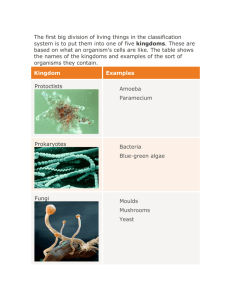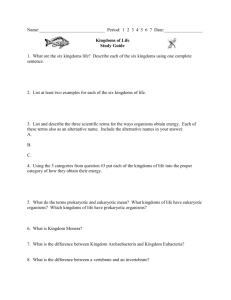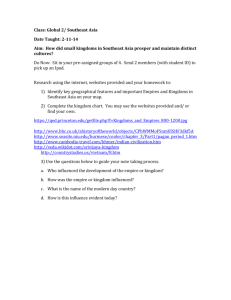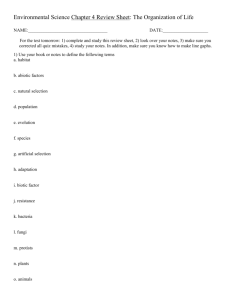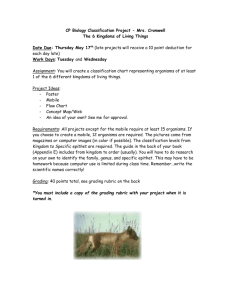Organizing Living things
advertisement
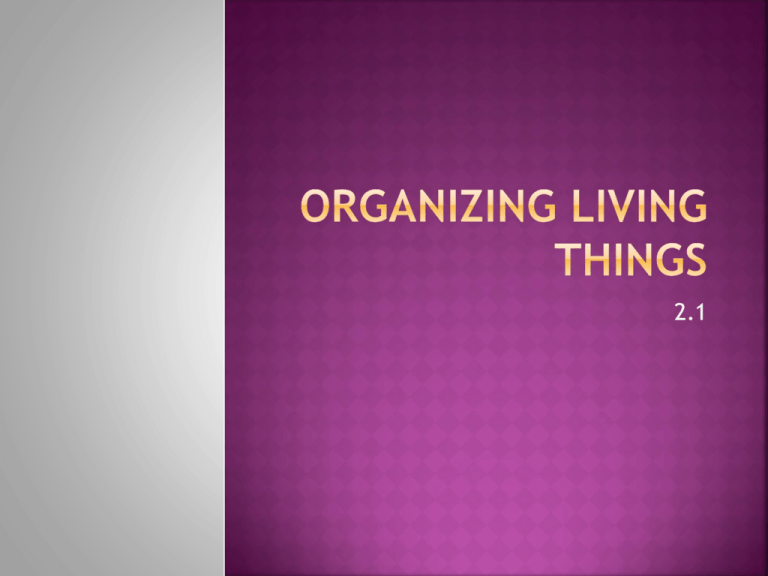
2.1 I can compare and contrast living and nonliving things I can explain the current classification system of 3 domains and 6 kingdoms I can describe the similarities and differences between living things in different kingdoms Living Things 1. Made of cells 2. Carry out basic life activities 3. Grouped into Kingdoms Plant Animal Fungi Protist Archea Bacteria Eubacteria A property is a quality that describes an object Properties can describe how an object looks or feels Properties can also describe how an object acts We observe properties (sight, touch, smell, taste) Examples: A property of a rock is its hardness A property of a person is their eye color Properties: Color Texture Mass Density Shape Size (height/weight) Metallic Luster Malleable Smell Taste Carry out basic life activities Do Can Do move Grow, develop, and reproduce Called organisms not carry out basic life activities not move by themselves Do not develop, grow or reproduce Not made of cells An organism is any living thing that can carry out basic life activities A complete, individual living thing Organisms: _______________________________ _______________________________ _______________________________ _______________________________ _______________________________ _______________________________ _______________________________ _______________________________ _______________________________ What are the 7 basic life activities? 1. Growth 2. Development 3. Getting food 4. Using food and removing wastes 5. Reproduction 6. Sensing and Responding 7. Movement Property Organism Read pages 31-33 Self Check Questions pg. 33 #1-5 USE COMPLETE SENTENCES 2.2 Living things are more like one another than they are like non-living things Example: They all carry out basic life activities However, living things are also very different from one another Example: A cat is different from a dog All living things are divided into a classification system: Kingdom (King) Phylum (Philip) Class (Claimed) Order (Only) Family (Five) Genus (Gold) Species (Shoes) Taxonomy means classification All living things stem from a common ancestor Carl Linnaeus developed an organization system in 1758 His system only had two kingdoms: Plant and Animal This system stayed unchanged until the 1960’s In 1969, Thomas Whittaker proposed a 5 kingdom system He added Fungus, Protist and Monera to the existing kingdoms Plant and Animal Whittaker defined the kingdoms on the basis of if they possessed a true nucleus (eukaryotic) Monera do not possess a true nucleus (prokaryotic) The other 4 kingdoms are eukaryotic New evidence supports that the 5 kingdom system is not correct As more and more unicellular organisms are being discovered, these organisms also appear to be prokaryotic (no true nucleus) These organisms did not fit into the Monera kingdom at all In the 1980’s, Carl Woese proposed a radical reorganization of the 5 kingdoms into 3 domains Carl Woese’s design has been increasingly accepted by biologists over the years It is now the standard theory In his system, Woese placed all 4 eukaryotic kingdoms into one, single domain called Eukarya Then, he split the Monera Kingdom into 2 Domains: Eubacteria (bacteria) and Archaea (archaebacteria) He also placed most of the “unusual” prokaryotes (no true nucleus) in Archaea The plant and animal kingdoms were demoted as individual kingdoms They are now within a domain This is consistent with recent discoveries of more diversity among microbes Woese’s 3 Domain system organizes biodiversity by evolutionary relationships rather than properties New Classification Chart Kingdom Algae Microorganism Protist Protozoan Taxonomy Read Cilia Decompose Flagella Eukaryotic Pseudopod Prokaryotic pages 36-39 Self Check Questions pg. 39 #1-5 USE COMPLETE SENTENCES You and a partner will be assigned one of the Domains/Kingdoms to investigate You will create a poster outlining your Domain/Kingdom and present to the class Your poster will include background information, vocabulary associated, example organisms, recent findings, pictures, etc. Your poster must be colorful and creative You and your partner MUST WORK TOGETHER

